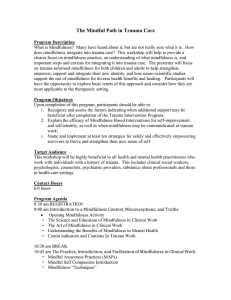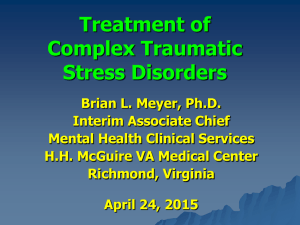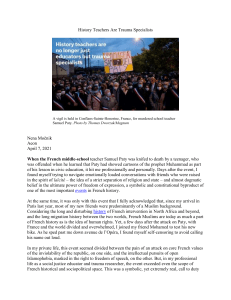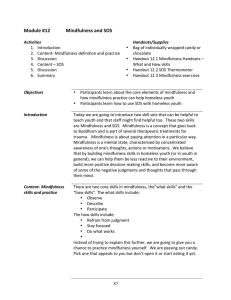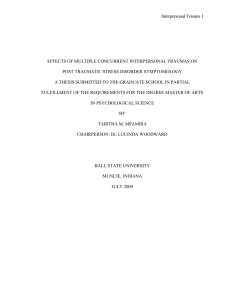Powerpoint slides - Counseling Center Village
advertisement
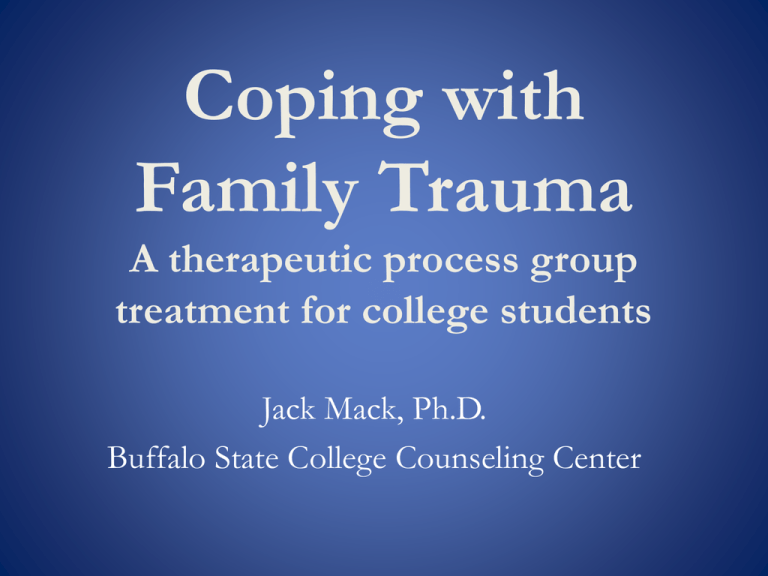
Coping with Family Trauma A therapeutic process group treatment for college students Jack Mack, Ph.D. Buffalo State College Counseling Center Outline • • • • • • • • Basic structure Group agreements and norms Screening and construction Process vs. support group Mindfulness Common themes, challenges, interventions Why this group works, client feedback Q&A Basic Structure • Theme / Purpose – 66% of college students reported Criterion A trauma – 9% met criteria for PTSD • Description of group – Length/Frequency – What we do each week – Our stance • Short term (1 semester w/ option to continue) • Recruitment (what we tell our colleagues) • Leader(s) – ideally male/female coleaders Read, J.P., Ouimette, P., White, J., Colder, C., & Farrow, S. (2011). Rates of DSM-IV-TR trauma exposure and posttraumatic stress disorder among newly matriculated college students. Psychological Trauma: Theory, Research Practice, and Policy, 3(2), 148-156. Basic Structure • Mindfulness exercise • Check-in – How are you feeling right now? (Feelings Wheel) – Any updates on family contact since last group? – Any specific topic/issue to address today? • Group process (based on above) • Check-out – How are you feeling right now? – What is something from group you connected with? – What is a small goal you could work on before next group? Group Screening & Construction • Hand out screening form • What goes into group construction? – Demographics (gender, age, grad or undergrad) – Matching vs. Diversity – What types of traumas fit in group? – Heterogeneity vs. homogeneity (Yalom, 1985) – Potential problems (leaders, wallflowers, attendance, boundary issues, talking too much or too little, etc.) • Rule-out criteria Group agreement and norms • • • • • • • Confidentiality, limits of confidentiality No contact outside group, subgrouping Attendance Commitment (at least 3 sessions) No physical contact I-statements Asking members for what they want to add, put it in their own words Process Group vs. Support Group vs. Structured Group • We don’t have an agenda, but we have themes/skills that we cover • Some structure (check-in, check-out) open process part is sandwiched in the middle • Process—present oriented, coping oriented • Activities based on group topics/interest • Emphasis is not processing trauma, more helping to cope w/ trauma in the present Mindfulness Exercise • We begin and end with a mindfulness and/or relaxation exercise. • Demonstrate difference techniques over the semester. – Breathing – Movement – PMR – Guided meditation – Apps Common Themes • • • • • • • • Anxiety, depression, PTSD Triggers Balance, self-care “Overcontrolled” vs. “Undercontrolled” reactions to trauma Boundaries with family, friends, partners Emotional intelligence/processing Loneliness, stigma Replicating family patterns – Substance use/abuse – Chaotic relationships • Trust, acceptance, and/or forgiveness • Siblings, roles in family • Reasonable goals/expectations for self/family Common Challenges • • • • • • • • Attendance (group and individual) Current traumas vs. past traumas Disorganization Trust Subgrouping (age, gender, type of trauma) Crisis management Clients acting in therapist/helper role Termination, saying goodbye healthily Common Interventions • Present/coping-focused • Setting reasonable/attainable goals • Skill building – mindfulness, self-validation, seeking social support and safety • Psychoeducation • Understanding/improving communication – I statements – Speaking the unspoken – Ask for/give direct feedback when it feels safe • “Genograms” – What does your family look like? What is each person’s role? Has this changed? How would you change it? Why this group works • • • • • • • • Universality, reduced isolation Validation Emotional processing Problem solving Interpersonal feedback/learning/practice Altruism, pride, resilience Reinforcing strengths Installation of hope Yalom, I.D. (1995). The theory and practice of group psychotherapy (4th ed.). New York: Basic Books. Anonymous client feedback (used with permission) • “I got a lot of good feedback from people who understood where I was coming from and I think that really helped.” • “I never thought that being in this group would be as hard as it was and I didn’t think it would have such a profound effect.” • “It really helped me to cope with my depression.” • “I didn’t expect that I would have such a positive impact on other group members. It was amazing to hear feedback from peers, pointing to strengths they see in me, especially when I feel so broken.” • “It definitely pushed me to take risks in a healthy, unintimidating way, and it helped me seek and give support to others.” • “I am not alone.” Questions?







